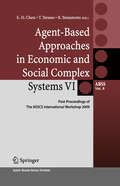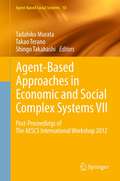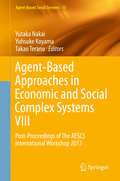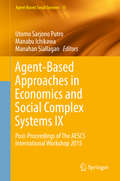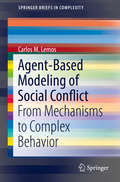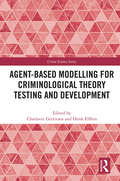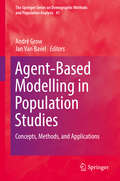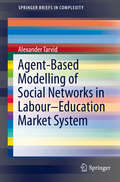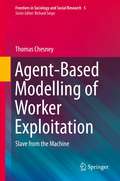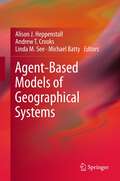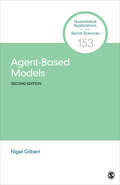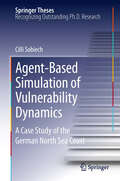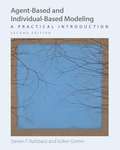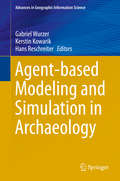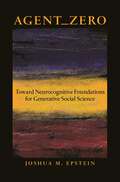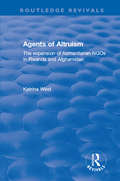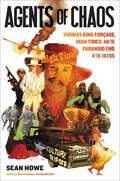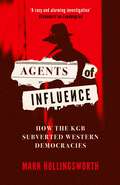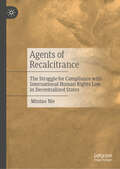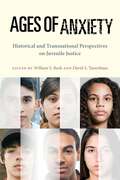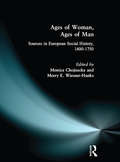- Table View
- List View
Agent-Based Approaches in Economic and Social Complex Systems VI: Post-Proceedings of The AESCS International Workshop 2009 (Agent-Based Social Systems #8)
by Takao Terano Ryuichi Yamamoto Shu-Heng ChenAgent-based modeling/simulation is an emergent approach to the analysis of social and economic systems. It provides a bottom-up experimental method to be applied to social sciences such as economics, management, sociology, and politics as well as some engineering fields dealing with social activities. This book includes selected papers presented at the Sixth International Workshop on Agent-Based Approaches in Economic and Social Complex Systems held in Taipei in 2009. We have 39 presentations in the conference, and 14 papers are selected to be included in this volume. These 14 papers are then grouped into six parts: Agent-based financial markets; Financial forecasting and investment; Cognitive modeling of agents; Complexity and policy analysis; Agent-based modeling of good societies; and Miscellany. The research presented here shows the state of the art in this rapidly growing field.
Agent-Based Approaches in Economic and Social Complex Systems VII: Post-Proceedings of The AESCS International Workshop 2012 (Agent-Based Social Systems #10)
by Takao Terano Shingo Takahashi Tadahiko MurataAgent-based modeling/simulation is an emergent approach to the analysis of social and economic systems. It provides a bottom-up experimental method to be applied to social sciences such as economics, management, sociology, and politics as well as some engineering fields dealing with social activities. This book includes selected papers presented at the Seventh International Workshop on Agent-Based Approaches in Economic and Social Complex Systems held in Osaka, Japan, in 2012. At the workshop, 24 reviewed full papers were presented, and of those, 17 were selected to be included in this volume. The papers are divided into two groups as "Fundamentals of Agent-Based Modeling" and "Applications of Agent-Based Modeling".
Agent-Based Approaches in Economic and Social Complex Systems VIII: Post-Proceedings of The AESCS International Workshop 2013 (Agent-Based Social Systems #13)
by Takao Terano Yutaka Nakai Yuhsuke KoyamaAgent-based modeling/simulation is an emergent approach to the analysis of social and economic systems. It provides a bottom-up experimental method to be applied to social sciences such as economics, management, sociology and politics as well as some engineering fields dealing with social activities. This book includes selected papers presented at the Eighth International Workshop on Agent-Based Approaches in Economic and Social Complex Systems held in Tokyo, Japan, in 2013. At the workshop, 23 reviewed full papers were presented and of those, 13 were selected to be included in this volume.
Agent-Based Approaches in Economics and Social Complex Systems IX: Post-Proceedings of The AESCS International Workshop 2015 (Agent-Based Social Systems #15)
by Utomo Sarjono Putro Manabu Ichikawa Manahan SiallaganThis book includes many cases that provide new perspectives in developing agent-based modeling and simulation. The real problems are complex, and sophisticated methodology is needed to handle them. Agent-based modeling and simulation is one methodology that provides a bottom-up experimental approach applicable to social sciences such as economics, management, sociology, and politics as well as some engineering fields dealing with social activities. However, to improve the applicability of agent-based modeling and simulation methods, a new perspective is needed. In this book, that new perspective is developed and utilized to deal with many cases of real-world problems such as the supply chain, land use and land cover, transportation, health, services, economics, and social problems. The cases are selected from papers presented at the Ninth International Workshop on Agent-Based Approaches in Economic and Social Complex Systems held in Bali, Indonesia, in 2015. At the workshop, 29 reviewed full papers were presented, and of those, 16 were selected to be included in this volume.
Agent-Based Modeling of Social Conflict: From Mechanisms to Complex Behavior (SpringerBriefs in Complexity)
by Carlos M. LemosThis Brief revisits and extends Epstein's classical agent-based model of civil violence by considering important mechanisms suggested by social conflict theories. Among them are: relative deprivation as generator of hardship, generalized vanishing of the risk perception ('massive fear loss') when the uprisings surpass a certain threshold, endogenous legitimacy feedback, and network influence effects represented by the mechanism of dispositional contagion. The model is explored in a set of computer experiments designed to provide insight on how mechanisms lead to increased complexity of the solutions. The results of the simulations are compared with statistical analyses of estimated size, duration and recurrence of large demonstrations and riots for eight African countries affected by the "Arab Spring," based on the Social Conflict Analysis Database. It is shown that the extensions to Epstein's model proposed herein lead to increased "generative capacity" of the agent-based model (i. e. a richer set of meaningful qualitative behaviors) as well the identification of key mechanisms and associated parameters with tipping points. The use of quantitative information (international indicators and statistical analyses of conflict events) allows the assessment of the plausibility of input parameter values and simulated results, and thus a better understanding of the model's strengths and limitations. The contributions of the present work for understanding how mechanisms of large scale conflict lead to complex behavior include a new form of the estimated arrest probability, a simple representation of political vs economic deprivation with a parameter which controls the `sensitivity' to value, endogenous legitimacy feedback, and the effect of network influences (due to small groups and "activists"). In addition, the analysis of the Social Conflict Analysis Database provided a quantitative description of the impact of the "Arab Spring" in several countries focused on complexity issues such as peaceful vs violent, spontaneous vs organized, and patterns of size, duration and recurrence of conflict events in this recent and important large-scale conflict process. This book will appeal to students and researchers working in these computational social science subfields.
Agent-Based Modelling and Geographical Information Systems: A Practical Primer (Spatial Analytics and GIS)
by Andrew Crooks Nick Malleson Dr Ed Manley Alison HeppenstallThis is the era of Big Data and computational social science. It is an era that requires tools which can do more than visualise data but also model the complex relation between data and human action, and interaction. Agent-Based Models (ABM) - computational models which simulate human action and interaction – do just that. This textbook explains how to design and build ABM and how to link the models to Geographical Information Systems. It guides you from the basics through to constructing more complex models which work with data and human behaviour in a spatial context. All of the fundamental concepts are explained and related to practical examples to facilitate learning (with models developed in NetLogo with all code examples available on the accompanying website). You will be able to use these models to develop your own applications and link, where appropriate, to Geographical Information Systems. All of the key ideas and methods are explained in detail: geographical modelling; an introduction to ABM; the fundamentals of Geographical Information Science; why ABM and GIS; using QGIS; designing and building an ABM; calibration and validation; modelling human behaviour; visualisation and 3D ABM; using Big Geosocial Data, GIS and ABM. An applied primer, that provides fundamental knowledge and practical skills, it will provide you with the skills to build and run your own models, and to begin your own research projects.
Agent-Based Modelling and Geographical Information Systems: A Practical Primer (Spatial Analytics and GIS)
by Andrew Crooks Nick Malleson Dr Ed Manley Alison HeppenstallThis is the era of Big Data and computational social science. It is an era that requires tools which can do more than visualise data but also model the complex relation between data and human action, and interaction. Agent-Based Models (ABM) - computational models which simulate human action and interaction – do just that. This textbook explains how to design and build ABM and how to link the models to Geographical Information Systems. It guides you from the basics through to constructing more complex models which work with data and human behaviour in a spatial context. All of the fundamental concepts are explained and related to practical examples to facilitate learning (with models developed in NetLogo with all code examples available on the accompanying website). You will be able to use these models to develop your own applications and link, where appropriate, to Geographical Information Systems. All of the key ideas and methods are explained in detail: geographical modelling; an introduction to ABM; the fundamentals of Geographical Information Science; why ABM and GIS; using QGIS; designing and building an ABM; calibration and validation; modelling human behaviour; visualisation and 3D ABM; using Big Geosocial Data, GIS and ABM. An applied primer, that provides fundamental knowledge and practical skills, it will provide you with the skills to build and run your own models, and to begin your own research projects.
Agent-Based Modelling for Criminological Theory Testing and Development (Crime Science Series)
by Charlotte GerritsenAgent-Based Modelling for Criminological Theory Testing and Development addresses the question whether and how we can use simulation methods in order to test criminological theories, and if they fail to be corroborated, how we can use simulation to mend and further develop theories. It is by no means immediately obvious how results being observed in an artificial environment have any relevance for what is going on in the real world. By using the concept of a "stylized fact," the contributors bridge the gap between artificial and real world. With backgrounds in criminology or artificial intelligence (AI), these contributors present agent-based model studies that test aspects of various theories, including crime pattern theory, guardianship in action theory, near repeat theory, routine activity theory, and general deterrence theory. All six simulation models presented have been specially developed for the book. Contributors have specified the theory, identified stylized facts, developed an agent-based simulation model, let it run, and interpreted whether the chosen stylized fact is occurring in their model, and what we should conclude from congruence or incongruence between simulation and expectations based on the theory under scrutiny. The final chapter discusses what can be learnt from these six enterprises. The book will be of great interest to scholars of criminology (in particular computational criminologists and theoretical criminologists) and AI (with an emphasis on AI for generative social processes), and more widely researchers in social science in general. It will also be valuable for master's courses in quantitative criminology.
Agent-Based Modelling in Population Studies: Concepts, Methods, and Applications (The Springer Series on Demographic Methods and Population Analysis #41)
by André Grow Jan Van BavelThis book examines the use of agent-based modelling (ABM) in population studies, from concepts to applications, best practices to future developments. It features papers written by leading experts in the field that will help readers to better understand the usefulness of ABM for forecasting, how ABM can be injected with empirical data to achieve a better match between model and reality, how geographic information can be fruitfully used in ABM, and how ABM results can effectively and correctly be reported in a concise way. Overall, coverage ranges from detailing methods of agent-based modelling to existing paradigms in population studies to infusing agent-based models with empirical data. The papers show the benefits that ABM offers the field, such as enhanced theory formation by better linking the micro-level with the macro-level, the ability to represent populations more adequately as complex systems, and a way that laboratories can study rare events and the implications of alternative mechanisms. In addition, readers will discover guidelines and best-practices with detailed examples of how to apply agent-based models in different areas of population research, including human mating behaviour, migration, and socio-structural determinants of health behaviours. This book collects papers from the workshop "Recent Developments and Future Directions in Agent-Based Modelling in Population Studies," which took place at the University of Leuven, Belgium in September 2014. It will contribute to the development of best-practices in the field and will provide a solid point of reference for scholars who want to start using agent-based modelling in their own research.
Agent-Based Modelling of Social Networks in Labour-Education Market System (SpringerBriefs in Complexity)
by Alexander TarvidThis book covers the modelling of human behaviour in the education and labour markets, which due to their interdependency are viewed as one system. Important factors influencing the decision-making of individuals and firms in this system are discussed. The role of social environment and networks is stressed. The approach of agent-based modelling is presented and compared with standard economic modelling and other simulation techniques in the context of modelling complex adaptive systems. Practical questions in building agent-based models of labour-education market system with social networks are discussed. These questions include modelling the structure of education system and agent behaviour there; modelling and calibrating the labour market without and with firms; generating the social network, defining its behaviour and calibrating it; and embedding the resulting system into a larger model.
Agent-Based Modelling of Worker Exploitation: Slave from the Machine (Frontiers in Sociology and Social Research #5)
by Thomas ChesneyThis book illustrates the potential for computer simulation in the study of modern slavery and worker abuse, and by extension in all social issues. It lays out a philosophy of how agent-based modelling can be used in the social sciences. In addressing modern slavery, Chesney considers precarious work that is vulnerable to abuse, like sweat-shop labour and prostitution, and shows how agent modelling can be used to study, understand and fight abuse in these areas. He explores the philosophy, application and practice of agent modelling through the popular and free software NetLogo. This topical book is grounded in the technology needed to address the messy, chaotic, real world problems that humanity faces—in this case the serious problem of abuse at work—but equally in the social sciences which are needed to avoid the unintended consequences inherent to human responses. It includes a short but extensive NetLogo guide which readers can use to quickly learn this software and go on to develop complex models. This is an important book for students and researchers of computational social science and others interested in agent-based modelling.
Agent-Based Models of Geographical Systems
by Michael Batty Alison J. Heppenstall Andrew T. Crooks Linda M. SeeThis unique book brings together a comprehensive set of papers on the background, theory, technical issues and applications of agent-based modelling (ABM) within geographical systems. This collection of papers is an invaluable reference point for the experienced agent-based modeller as well those new to the area. Specific geographical issues such as handling scale and space are dealt with as well as practical advice from leading experts about designing and creating ABMs, handling complexity, visualising and validating model outputs. With contributions from many of the world's leading research institutions, the latest applied research (micro and macro applications) from around the globe exemplify what can be achieved in geographical context. This book is relevant to researchers, postgraduate and advanced undergraduate students, and professionals in the areas of quantitative geography, spatial analysis, spatial modelling, social simulation modelling and geographical information sciences.
Agent-Based Models: Agent-based Modelling Using The Skin Platform (Quantitative Applications in the Social Sciences #153)
by Nigel GilbertAgent-based simulation has become increasingly popular as a modeling approach in the social sciences because it enables researchers to build models where individual entities and their interactions are directly represented. The Second Edition of Nigel Gilbert′s Agent-Based Models introduces this technique; considers a range of methodological and theoretical issues; shows how to design an agent-based model, with a simple example; offers some practical advice about developing, verifying and validating agent-based models; and finally discusses how to plan an agent-based modelling project, publish the results and apply agent-based modeling to formulate and evaluate social and economic policies.
Agent-Based Models: Agent-based Modelling Using The Skin Platform (Quantitative Applications in the Social Sciences #153)
by Nigel GilbertAgent-based simulation has become increasingly popular as a modeling approach in the social sciences because it enables researchers to build models where individual entities and their interactions are directly represented. The Second Edition of Nigel Gilbert′s Agent-Based Models introduces this technique; considers a range of methodological and theoretical issues; shows how to design an agent-based model, with a simple example; offers some practical advice about developing, verifying and validating agent-based models; and finally discusses how to plan an agent-based modelling project, publish the results and apply agent-based modeling to formulate and evaluate social and economic policies.
Agent-Based Simulation of Vulnerability Dynamics: A Case Study of the German North Sea Coast (Springer Theses)
by Cilli SobiechThis thesis constitutes an extraordinary innovative research approach in transferring the concepts and methods of complex systems to risk research. It ambitiously bridges the barriers between theoretical, empirical and methodical research work and integrates these fields into one comprehensive approach of dealing with uncertainty in socio-ecological systems. The developed agent-based simulation aims at the dynamics of social vulnerability in the considered system of the German North Sea Coast. Thus, the social simulation provides an analytical method to explore the individual, relational, and spatial aspects leading to dynamics of vulnerability in society. Combining complexity science and risk research by the method of agent-based simulation hereby emphasizes the importance of understanding interrelations inside the system for the system's development, i.e. for the evolving. Based on a vulnerability assessment regarding vulnerability characteristics, present risk behavior and self-protection preferences of private households against the impacts of flooding and storm surges, possible system trajectories could be explored by means of simulation experiments. The system-analytical approach therefore contributes to an integrated consideration of multi-dimensional and context-sensitv social phenomena such as vulnerability. Furthermore it achieves conceptually and strategically relevant implications for risk research and complex systems research.
Agent-Based and Individual-Based Modeling: A Practical Introduction, Second Edition
by Volker Grimm Steven F. RailsbackThe essential textbook on agent-based modeling—now fully updated and expandedAgent-Based and Individual-Based Modeling has become the standard textbook on the subject for classroom use and self-instruction. Drawing on the latest version of NetLogo and fully updated with new examples, exercises, and an enhanced text for easier comprehension, this is the essential resource for anyone seeking to understand how the dynamics of biological, social, and other complex systems arise from the characteristics of the agents that make up these systems.Steven Railsback and Volker Grimm lead students stepwise through the processes of designing, programming, documenting, and doing scientific research with agent-based models, focusing on the adaptive behaviors that make these models necessary. They cover the fundamentals of modeling and model analysis, introduce key modeling concepts, and demonstrate how to implement them using NetLogo. They also address pattern-oriented modeling, an invaluable strategy for modeling real-world problems and developing theory.This accessible and authoritative book focuses on modeling as a tool for understanding real complex systems. It explains how to pose a specific question, use observations from actual systems to design models, write and test software, and more.A hands-on introduction that guides students from conceptual design to computer implementation to analysisFilled with new examples and exercises and compatible with the latest version of NetLogoIdeal for students and researchers across the natural and social sciencesWritten by two leading practitionersSupported by extensive instructional materials at www.railsback-grimm-abm-book.com
Agent-based Modeling and Simulation in Archaeology (Advances in Geographic Information Science)
by Gabriel Wurzer Kerstin Kowarik Hans ReschreiterArchaeology has been historically reluctant to embrace the subject of agent-based simulation, since it was seen as being used to "re-enact" and "visualize" possible scenarios for a wider (generally non-scientific) audience, based on scarce and fuzzy data. Furthermore, modeling "in exact terms" and programming as a means for producing agent-based simulations were simply beyond the field of the social sciences. This situation has changed quite drastically with the advent of the internet age: Data, it seems, is now ubiquitous. Researchers have switched from simply collecting data to filtering, selecting and deriving insights in a cybernetic manner. Agent-based simulation is one of the tools used to glean information from highly complex excavation sites according to formalized models, capturing essential properties in a highly abstract and yet spatial manner. As such, the goal of this book is to present an overview of techniques used and work conducted in that field, drawing on the experience of practitioners.
Agent_Zero: Toward Neurocognitive Foundations for Generative Social Science (Princeton Studies in Complexity #25)
by Joshua M. EpsteinThe Final Volume of the Groundbreaking Trilogy on Agent-Based ModelingIn this pioneering synthesis, Joshua Epstein introduces a new theoretical entity: Agent_Zero. This software individual, or "agent," is endowed with distinct emotional/affective, cognitive/deliberative, and social modules. Grounded in contemporary neuroscience, these internal components interact to generate observed, often far-from-rational, individual behavior. When multiple agents of this new type move and interact spatially, they collectively generate an astonishing range of dynamics spanning the fields of social conflict, psychology, public health, law, network science, and economics.Epstein weaves a computational tapestry with threads from Plato, Hume, Darwin, Pavlov, Smith, Tolstoy, Marx, James, and Dostoevsky, among others. This transformative synthesis of social philosophy, cognitive neuroscience, and agent-based modeling will fascinate scholars and students of every stripe. Epstein's computer programs are provided in the book or on its Princeton University Press website, along with movies of his "computational parables.?Agent_Zero is a signal departure in what it includes (e.g., a new synthesis of neurally grounded internal modules), what it eschews (e.g., standard behavioral imitation), the phenomena it generates (from genocide to financial panic), and the modeling arsenal it offers the scientific community. For generative social science, Agent_Zero presents a groundbreaking vision and the tools to realize it.
Agents of Altruism: The Expansion of Humanitarian NGOs in Rwanda and Afghanistan (Routledge Revivals)
by Katrina WestThis title was first published in 27/11/2001: Humanitarian nongovernmental organizations (NGOs) grew significantly in the last decades of the 20th century. The international NGO community today is a rich world of professional bodies, local organizations, mammoth multinationals, charities, advocacy groups, business-like organizations, ad hoc agencies and voluntary associations. Humanitarian NGOs are powerful actors in conflict regions and influential campaigners at the international level. What are the reasons behind their growth? In answering that question, this book focuses on how and when NGOs became influential in humanitarian crises. Four case studies in Rwanda and Afghanistan are examined. The earliest is the crisis in Rwanda in the 1960s, when only a few NGOs operated in Rwanda with limited budgets and experience. The second case study is the Soviet invasion of Afghanistan in 1979-89, by which time NGOs had developed considerably: by then they were operating on a global scale, receiving more funds, having closer ties with the media, executing bigger projects and had also become more professional. The second Afghan case study focuses on the mujahidin and Taliban rule, while the second Rwandan study centres on the 1994 genocide. These two studies reveal that enormous changes have taken place in the humanitarian NGO community since the 1980s. In this way, this book characterizes the changes that have taken place and then offers explanations for the nature and speed of the growth and change.
Agents of Chaos: Thomas King Forçade, High Times, and the Paranoid End of the 1970s
by Sean HoweThe life and times of High Times&’ enigmatic founder Thomas King Forçade, an underground newspaper editor and marijuana kingpin who—between police raids, smuggling runs, and outrageous stunts—battled both the US government and fellow radicals.Cover illustration by legendary comics artist Bill Sienkiewicz. At the end of the 1960s, the mysterious Tom Forçade suddenly appeared, insinuating himself into the top echelons of countercultural politics and assuming control of the Underground Press Syndicate, a coalition of newspapers across the country. Weathering government surveillance and harassment, he embarked on a landmark court battle to obtain White House press credentials. But his audacious exploits—pieing Congressional panelists, stealing presidential portraits, and picking fights with other activists—led to accusations that he was an agent provocateur. As the era of protest faded and the dark shadows of Watergate spread, Forçade hoped that marijuana could be the path to cultural and economic revolution. Bankrolled by drug-dealing profits, High Times would be the Playboy of pot, dragging a once-taboo subject into the mainstream. The magazine was a travelogue of globe-trotting adventure, a wellspring of news about &“the business,&” and an overnight success. But High Times soon threatened to become nothing more than the &“hip capitalism&” Forçade had railed against for so long, and he felt his enemies closing in. Assembled from exclusive interviews, archived correspondences, and declassified documents, Agents of Chaos is a tale of attacks on journalism, disinformation campaigns, governmental secrecy, corporatism, and political factionalism. Its triumphs and tragedies mirror the cultural transformations of 1970s America, wrought by forces that continue to clash in the spaces between activism and power.
Agents of Empire
by Lisa ChiltonThe period between the 1860s and the 1920s saw a wave of female migration from Britain to Canada and Australia, much of which was managed by women. In Agents of Empire, Lisa Chilton explores the work of the women who promoted, managed, and ultimately transformed single British women's experiences of migration.Chilton examines the origins of women-run female emigration societies through various aspects of their work and the responses they received from emigrants and settled colonists. Working in the face of apathy in the community, resistance by other (usually male) managers of imperial migration, and agency exerted by the women they sought to manage, the emigrators endeavoured to maintain control over the field until government agencies took it over in the aftermath of the First World War. Agents of Empire highlights the aims and methods behind the emigrators' work, as well as the implications and ramifications of their long-term engagement with this imperialistic feminizing project. Chilton provides tremendous insight into the struggle for control of female migration and female migrants, aiding greatly in the study of gender, migration, and empire.
Agents of Influence: How the KGB Subverted Western Democracies
by Mark HollingsworthThere&’s no such thing as a former KGB man. Agents of Influence reveals the secret history of an intelligence agency gone out of control, accountable to no one but itself and intent on subverting Western politics on a near-inconceivable scale. In 1985, 1,300 KGB officers were stationed in the USA. The FBI only had 350 counter-intelligence officers. Since the early days of the Cold War, the KGB seduced parliamentarians and diplomats, infiltrated the highest echelons of the Civil Service, and planted fake news in papers across the world. More disturbingly, it never stopped. Putin is a KGB man through and through. Journalist Mark Hollingworth reveals how disinformation, kompromat and secret surveillance continue to play key roles in Russia&’s war with Ukraine. It seems frighteningly easy to destabilise Western democracy.
Agents of Recalcitrance: The Struggle for Compliance with International Human Rights Law in Decentralized States
by Mintao NieFulfilling human rights treaty obligations extends beyond the mere ratification by national governments; it depends on the practices of local authorities, which continuously remake human rights standards and policies originating from higher levels of governance. In Agents of Recalcitrance: The Struggle for Compliance with International Human Rights Law in Decentralized States, Mintao Nie posits that governmental decentralization, characterized by increased autonomy for local authorities in local affairs, reduces state compliance with human rights treaties. This reduction occurs because governmental decentralization impedes the downward spread of human rights norms across governmental tiers, creates numerous local actors immune to moral pressure from the international society, and enables the central government to evade international censure by shifting blame for human rights abuses to local officials. This focus on central-local governmental relations challenges the assumption of states as unitary actors, offering a systematic understanding of how the varied motives and constraints across different levels of government affect the translation of international human rights law into local practice, in a volume that will interest scholars, activists and lawyers.
Ages of Anxiety: Historical and Transnational Perspectives on Juvenile Justice (Youth, Crime, and Justice #2)
by David S. Tanenhaus William S. BushSix compelling histories of youth crime in the twentieth century Ages of Anxiety presents six case studies of juvenile justice policy in the twentieth century from around the world, adding context to the urgent and international conversation about youth, crime, and justice. By focusing on magistrates, social workers, probation and police officers, and youth themselves, editors William S. Bush and David S. Tanenhaus highlight the role of ordinary people as meaningful and consequential historical actors. After providing an international perspective on the social history of ideas about how children are different from adults, the contributors explain why those differences should matter for the administration of justice. They examine how reformers used the idea of modernization to build and legitimize juvenile justice systems in Europe and Mexico, and present histories of policing and punishing youth crime. Ages of Anxiety introduces a new theoretical model for interpreting historical research to demonstrate the usefulness of social histories of children and youth for policy analysis and decision-making in the twenty-first century. Shedding new light on the substantive aims of the juvenile court, the book is a historically informed perspective on the critical topic of youth, crime, and justice.
Ages of Woman, Ages of Man: Sources in European Social History, 1400-1750
by Merry Wiesner Hanks Monica ChojnackaThe collection is organized around two main principles, stages of life and gender, and is divided into eight chapters: childhood, youth and sexuality, courtship and weddings, married life, economic life, networks and communities, and widowhood and old age. The sources address the numerous and varied ways in which women and men’s notions of themselves affected their lives, and explore how accepted norms of masculine and feminine behaviour influenced social, economic, and religious change. Guided by a general editors' introduction and then an introduction to each chapter, the user will find this an invaluable reference companion to early modern gender history.
